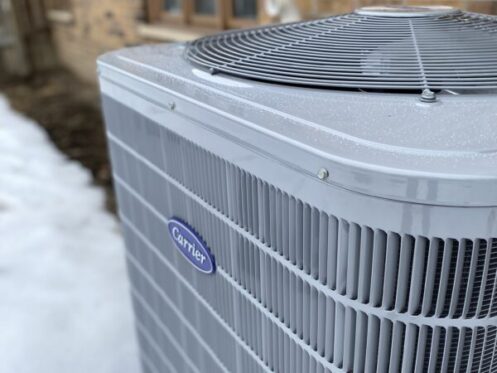Mold in an air conditioning unit is a fairly common problem, especially during the humid summer months in Tigard, OR. Not only does mold exposure affect your health, but it can also cause damage to your home and the AC system itself. Fortunately, there are steps you can take to identify and eliminate mold from your AC unit before it becomes a severe issue. Let’s discuss what causes mold to grow in air conditioners and how to remove it safely.
Signs That Mold is Growing in an AC Unit
Mold spores can circulate in the air. They can quickly multiply and spread throughout a building when they find their way into an air conditioning system. Unfortunately, most people don’t realize that mold is growing inside their AC unit or HVAC system until it’s a widespread problem. Some signs of potential mold growth in air conditioners include:
- Visible mold growth
- Musty odor
- An increase in allergies
- Clogged condensate drains
What to Do If Mold is Found in an AC Unit
After identifying that mold is present in your AC unit, it’s important to take steps to have the mold removed. The first step would be to turn off your AC unit to stop the mold spores from spreading further. You should also proceed with the following.
1. Having the AC Unit Inspected
An inspection allows a professional to identify that mold is present. It’s also imperative that the extent of mold growth be determined. An inspection will start by visually examining the outside of the air conditioner unit for signs of mold growth or water damage. It’s also important to check the air filter, ductwork, and handler, which can be breeding grounds for mold if they become damaged or wet due to improper maintenance. A professional may also test the air quality of your home to determine if there are any airborne mold spores.
During an inspection, a professional may take samples of the affected area to identify the type of mold present. This allows for a more precise recommendation regarding the best way to clean up the mold. After the inspection, you should receive a written report outlining the steps needed to eliminate mold and prevent future problems.
2. Removing the Mold in the AC Unit
It’s essential to remove the parts of the AC unit that have been affected by mold. This helps prevent further contamination and the spread of mold spores throughout your home. An expert will use specialized tools to access and remove moldy components, such as filters, fan blades, and coils. Furthermore, they can check for any other signs of damage or wear in the system that could lead to future mold growth.
3. Cleaning Ductwork
Cleaning the ductwork will help remove mold particles or spores that have traveled through the air conditioning system. This involves using specialized equipment to remove any traces of mold and other contaminants without causing the spores to become airborne.
An expert will use vacuums and air scrubbers to remove mold spores and properly dispose of contaminated materials. They may also apply antimicrobial products to help prevent the further growth of mold or other organisms in the duct system. It’s worth noting that cleaning the ductwork is just one step in the remediation process. Other measures, like repairing leaks and replacing damaged insulation, may also be necessary to ensure the mold does not return.
4. Cleaning the Condensate Drip Tray
The condensate drip tray collects excess water from the evaporator coil and prevents it from entering the home environment. It can create the perfect breeding ground for mold and mildew. Therefore, it is essential to regularly drain and clean the condensate drip tray in your AC unit. This cleaning can take place once a year or more often as part of routine HVAC maintenance.
5. Cleaning the Evaporator Coil
The evaporator coil removes heat and moisture from the air as it passes through. Mold can begin to grow if it becomes covered with dirt or debris. Cleaning or replacing the evaporator coil will help prevent further mold growth and restore proper function to your AC unit.
6. Checking for Leaks
Leaks can cause the humidity levels within the system to become too high, leading to mold growth. An AC unit leak can result from various problems, such as degraded seals, improper installation, or damaged parts. These issues can also cause the refrigerant to leak from the unit, resulting in decreased cooling capacity and higher operating costs.
7. Allow the Unit to Dry
After all the cleaning has been completed, the unit will need to dry completely. This will help eliminate any remaining moisture or humidity within the system, which can prevent mold from growing.
Additionally, allowing the AC unit to dry allows any cleaning solutions used during vacuuming to evaporate. To ensure complete drying of all components of an AC unit, it is best practice to leave a fan running at low speed near or around the unit until all moisture has dissipated.
8. Vacuuming the Inside of the AC Unit
It’s not always easy to reach into the interior of an AC unit. A professional technician can use a vacuum to draw out any particles of dust or dirt that may be harboring mold growth. Vacuuming can also help remove any clumps of mold that may have accumulated within the unit. A professional will ensure a thorough cleaning by vacuuming around the visible parts of the unit and also behind and underneath.
9. Replacing Any Filters in the AC Unit
Mold spores travel through the air, looking for moist, dark places to settle and grow. The filter in your AC unit serves as a first line of defense against mold, dust, and dirt particles that could otherwise support mold growth. It is best to replace these filters every one to three months to ensure optimal performance from your AC unit.
What Causes Mold to Grow in AC Units
Identifying the cause of mold growth is important. Mold can grow in air conditioners due to a variety of factors, such as:
- Poor ventilation
- Improper maintenance
- Dirty coils
- High humidity
- Poor air quality
Solutions to Prevent Mold in Your AC
Mold thrives in environments with high moisture levels. First, ensure there are no leaks in the plumbing or roof. If the home is still humid, a dehumidifier can help keep humidity levels below 50% to prevent further growth. It’s crucial to choose the right size dehumidifier for your home.
You can also invest in a whole-home air purifier. Our Halo in-duct air purifier can remove mold, bacteria, and viruses in the air up to 99%. This can be especially beneficial if anyone in the home suffers from allergies or respiratory issues.
If you have noticed mold in your AC unit, it is essential to take the necessary steps to remove it and prevent it from growing in the future. Our routine maintenance service can help prevent mold growth and fix any problems contributing to a mold problem. We also offer indoor air quality assessments, heating and cooling installation, maintenance, and repair, and water heater service. We can also install generators. Contact Specialty Heating & Cooling LLC for more information or assistance with your AC unit.

